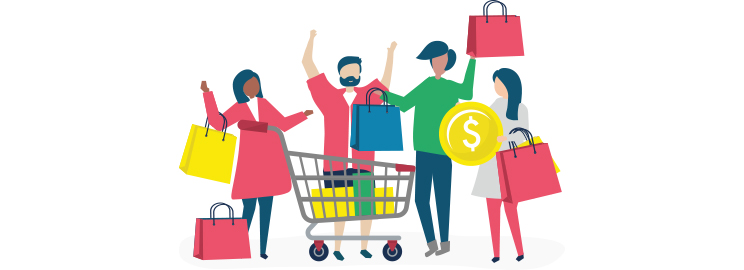How Can Retailers Capitalise Despite Challenging High Street Conditions? Why Traditional Retailers Need Digital Innovation
written by Giles Corbett
Blog8th February 2019
written by Giles Corbett
Blog8th February 2019

While many retailers are struggling today, others are thriving in spite of all the pressures.
What’s their secret? How are some retailers bucking the trend of decline and using technology to draw in new legions of committed customers?
In this article we look at the retailers who are finding a new way to succeed in retail, and consider how traditional retailers can embrace new opportunities to grow their customer bases and weather the storms battering our high streets.
While the ‘retail apocalypse’ may be something of a misnomer, or a media invention, it is undeniably true that retail is going through a period of transformation. Of course, the soaring popularity of online shopping is part of this story, but it’s also about rising costs, changing customer expectations, and a consolidation of retail environments following years of expansion.
In the UK alone, 85,000 jobs have been lost from the high street in 2018, with many major brands closing stores or going into administration. New Look, Mothercare and Homebase, Poundworld, Coast, Orla Kiely and Evans Cycles are a few examples of major retailers that have struggled or closed.
As businesses close, high streets and shopping centres become pock-marked by empty units, or overwhelmed by vaping stores, cafes and betting shops. While Internet shopping becomes more efficient and effective, traditional retail needs new reasons to exist. Shoppers need compelling new reasons to venture into the high street.
Given the wide-ranging pressures facing retailers, it might seem that the future is bleak for the high street.

But the news is not all negative. While some retailers are struggling, a few exemplars are fighting back and increasing sales. Examples include JD Sports, Lush cosmetics, Domino’s Pizza, Zara, and Primark.
Amazon has made major moves into physical retail, through their acquisition of Whole Foods and with their own Amazon Go stores. Amazon’s strategy is partly about obtaining the physical interface that stores provide, and partly about reducing rising shipping costs by giving people convenient locations to collect and drop off parcels. Amazon knows that, without physical retail environments, they can never have truly personal experiences with their customers – a huge disadvantage in an age that prizes connection and personalisation.
Fashion retailer Next similarly reports that half of its online customers go for the in-store collection, and then often end up buying additional items.
In China, ecommerce giant Alibaba is investing $8 billion in retail stores, because they also recognise the importance of physical outlets in their plans for growth.
These success stories are proof that retail in 2019 has plenty of opportunities. Yes, there are challenges facing the high street, but the reality is that some retailers are thriving in spite of these challenges, and others are thriving because they give customers compelling reasons to visit their shops.
The challenge, ultimately, is that businesses need to find a 21st Century model for physical retail.

What Amazon can’t do (WACD)
Some commentators are defining the challenge of modern retail as needing to do ‘What Amazon Can’t Do’ (WACD). Broadly speaking, this means maximising the opportunities provided by physical stores and human sales assistants. Specifically, this means providing personal experiences, mixing online and offline experiences, and offering spontaneous moments of joy.
Let’s explore some of the strategies that retailers are using to succeed in this time of change.
Online stores might run on technology, but they don’t have a monopoly.
Technology can be used in many different ways to complement real-world experiences, making them more meaningful and personal. Beena Nair, retail customer engagement consultant at Capgemini, believes that “AI, VR and chatbot technologies, for example, will enable customers to engage with brands using conversational UI.’
Technology can support customer service staff, engage customers, capture insights, enable offline-to-online ordering, and help customers browse ranges.
In JD Sports, part of their success may be attributed to their use of innovative technology that contributes to a premium feeling in-store. Staff can request shoes on a tablet, which are then delivered into the store on a conveyor belt. This reduces waiting time for shoes to try on, and gives sales assistants more opportunities to help customers explore their options.
How could in-store technology support your customers – and increase footfall?
Is your shop just a shop – or does it have more to offer? Retailers are increasingly looking for ways to expand their offerings so that people feel more welcome to stay and explore, rather than just dashing in to make a purchase. A common approach is to add a coffee shop or bar to your store, but some Topshop stores are adding DJs to improve the atmosphere for shoppers.

Disney Stores recognise that children want to touch toys and see how they work, so they make their products accessible and accept a little mess-making as a positive side-effect of being popular with kids. Peter Watson, MD of digital marketing agency Distract, reckons that Toys R Us should have stopped trying to be purely toy stores, and should have evolved into spaces to try and experience toys and fun activities. “This should have included entertainment sections in store, face painting zones and coffee centres for parents.”
What can you do that Amazon can’t? You have one huge asset that online retailers can’t compete with: a physical space that you can fill with surprises, treats and tangible experiences.
The key thing is to offer something new, something customers haven’t seen before. What can you add to your stores that will provide another point of interest? Can you create a playful experience? Or opportunities to explore what’s in-store?
While O2O was originally coined to describe digital retailers making a transition to traditional retail, some high street retailers are adopting the acronym to describe their reverse journeys, and their adoption of digital technology to support and embellish their traditional customer journeys.
Traditional retailers are searching for ways to give people the benefit of technology in-store. This includes facilitating in-store orders, developing stronger ecommerce offerings, enabling in-store collections and returns and generally shifting stores away from being purely a portal for transactions.
Physical retailers that embrace innovation and give customers delightful experiences tend to be better insulated from pressures like increasing costs and reduced footfall.
How can digital technologies embellish the shopping experience? Can you help customers choose products, or offer ancillary content that supports their purchases, or adds value?
For example, you could help customers assess their needs, and then provide guides, articles, advice or recipes related to their choices. These assets can be delivered digitally by photo capture, QR code or SMS, so the customer instantly has the information on their phone.
Deliveroo and Just Eat are good examples of digital platforms that are providing a boost for high-street casual dining establishments. These services may be a forerunner for other apps that can bring digital transformation to established retailers by connecting them seamlessly to customers, partners and suppliers.
How can you encourage people to visit your shops, and reward people for visiting? Incentives and gifts (including discount codes) can add to the sense of value that people get from visiting bricks-and-mortar shops. Pokemon-Go type experiences and badge collecting that encourage visits to multiple stores use gamification to create interest and encourage competition. It’s important that these offers feel exclusive, and not available online.
It’s clear that online shopping will continue to increase. But it will eventually find its limit – its growth in China, the world’s mobile commerce leader, has already slowed to low double digits, and high streets will rebalance according to the new level of demand.
In the meantime, the challenge for retailers is to find new ways to incorporate technology into their traditional stores, while also creating environments that are worth leaving the house for. Retailers that excel in this changing climate will be those who can give customers an experience that is greater than the sum of its parts. Retailers need to exploit the full potential of their real-world stores and do things that online retailers just can’t achieve. At the same time, physical retailers must adopt technology so that their stores don’t fall behind the capabilities of their digital competitors; customers should never have to lose out on choice, flexibility or convenience because they choose a physical shopping experience over a digital one.
Your store needs a way to keep up with the digital juggernauts. And that’s exactly what we’ve developed with our three strands of products: Smiles, Gamified Experiences and Cloudshelf.
Ksubaka screens create moments of joy for shoppers, while delivering a host of benefits for retailers. Our screens are deployed throughout Asia and Europe, where they help retailers get one more visitor, convert one more customer and add one more item in the basket.
Smiles is our interactive touchscreen that invites customers to engage via a single question, such as “How was your visit today?” – simply by tapping a smiley face.
Customers instantly rate their experience as positive, neutral or negative with a single tap. Once we’ve got their attention, we can ask follow-up questions, and begin building a picture of the thoughts, feelings and needs.
With Smiles, you measure satisfaction in the moment, capturing the real-time impressions, or pulse, of the people who are in your stores.
Why do companies use Smiles?
Ksubaka devices are installed in retail environments around the world. We understand the needs of different retailers, and how our technology can boost engagement, harvest insights and encourage exploration.
Contact our team if you would like to know more about Ksubaka Smiles, Gamified Experiences or Cloudshelf.